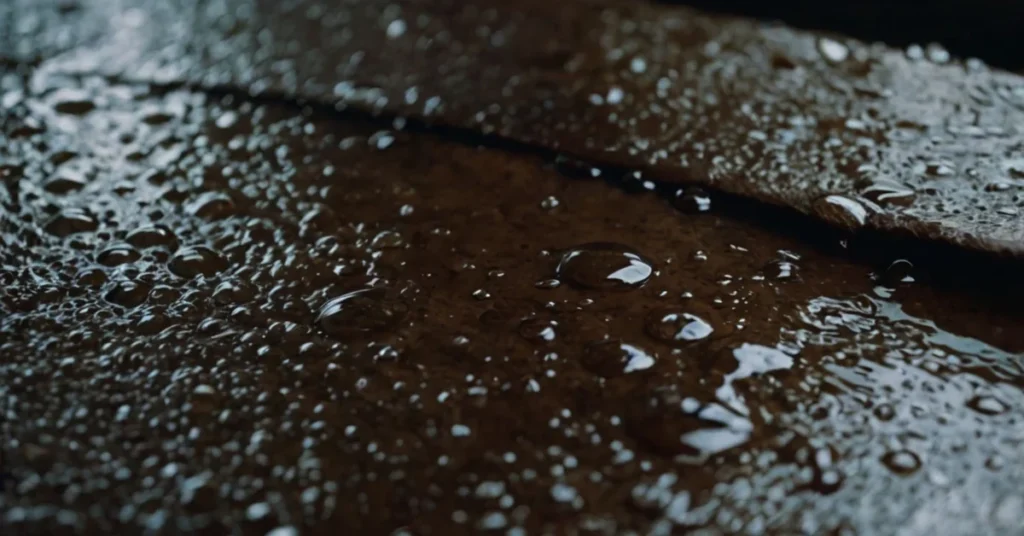Can leather get wet? Yes, leather can get wet, but it’s not ideal. Moisture penetrates its natural surface, draws out oils, and causes stiffness, cracks, or stains. Without proper waterproofing or care, leather becomes fragile, uncomfortable, and vulnerable to damage. Treated leather resists water better, but exposure and excessive soaking still risk lasting deterioration and reduced durability.
Is Leather Waterproof or Water-Resistant?
From years of experience working with different types of leather, one thing is clear: while it may look tough, it’s not completely waterproof. Leather is essentially animal skin, which makes it a natural, porous, and permeable material. The reality is, even a small amount of liquid like a light drizzle can find its way through the holes and pores of the surface.
Water can travel through, especially if it’s untreated. Even though leather can withstand brief exposure to water, it isn’t protected from getting soaked. Pieces can turn stiff, inflexible, and even lose that supple, special nature they once had.
If left wet too long, it can dry unevenly or—worst case—rot. Using full grain goat leather is highly recommended—it’s incredibly durable, and one of the most water resistant forms available. Regularly clean and treat leather goods with wax, conditioner, or a quality mixture of both to keep them as waterproof as possible.
Does Leather Shrink in Water?
Anyone who’s ever walked home from work in the rain, with shoes slowly getting drenched, knows that panic. The drop in temperature during winter, and the rush to wear them again tomorrow, makes it tempting to use a hair dryer or heater to quicken the drying process. But here’s the tip: don’t. Leather can shrink, lose shape, and even its integrity, especially when hot air hits a sodden surface.
It’s a common error — thinking a quick blast would help. But shrinkage can occur even in a small bag, jacket, or wallet. It’s not just an accident; sometimes it’s an intentional move when trying to make loose shoes fit better. Yes, people soak their shoes intentionally, hoping it gives an advantage, but that’s a risk. For those wondering, “Can leather get wet and still survive?” — it depends on what happens after it’s landed.
The scenario varies — some aim to shrink big shoes on purpose, others act without thinking, using a dryer without an umbrella moment to reflect. Whether due to human effort or plain neglect, careful handling is the key. And in every exception, natural air is safer. It’s a lesson in influence, intentionally or not.
Can You Wear Leather in the Rain?
Yes, you can—but be smart about it. A light drizzle won’t hurt, but heavy rain can mess up the shape and texture unless your leather is treated or covered.
The Science Behind Leather and Water
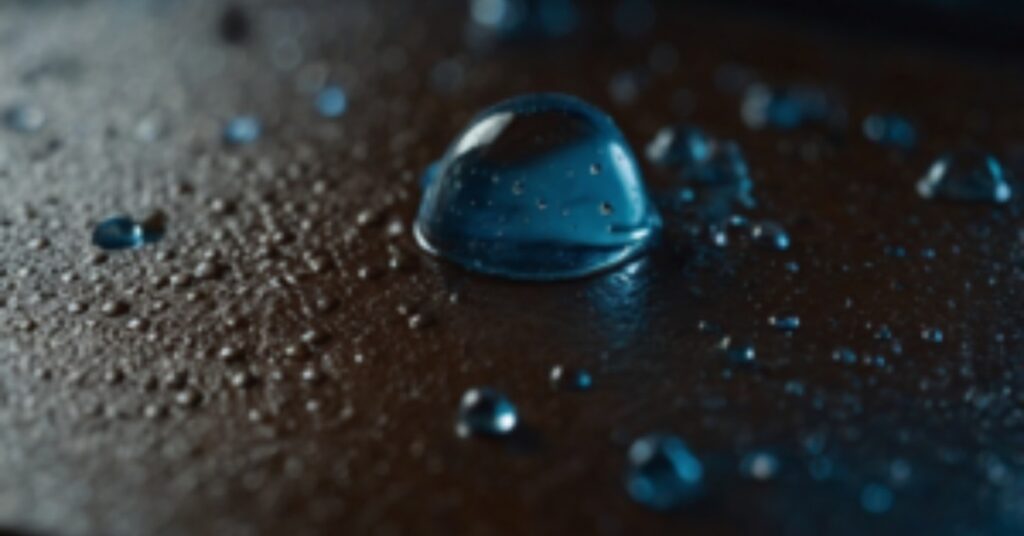
Can Leather Get Wet? The Science Bit
When leather gets wet, water molecules bind to the natural oils in the skin, and as it dries and evaporates, it starts drawing them out. This leaves the surface stiff, brittle, and no longer supple, with risks of staining, streaks, spots, and moved dyes. If not dried quickly, it may even rot—that’s the technical truth behind water damage.
Different Types of Leather
Smooth Vegetable-Tanned Leather
Vegetable-tanned leather made from the strongest part of the animal hide keeps its outermost layer and natural finish, which means it absorbs water easily and can show stains. Since it lacks protective coatings, I always focus on protecting it and regularly work on repairing damage to the skin using waxes on full-grain leather—that layer matters when preserving the look.
Grained or Patterned Leathers
Grained or chrome-tanned leathers, such as Saffiano or pebble, are typically finished with a solid, protective layer of paint that creates a high resistance to water. These types are less likely to get soaked or stain when compared to smooth or vegetable-tanned leather. As a general rule of thumb, always check the label for specific terms to understand the layer, surface, and protection levels.
Suede
Suede is highly sensitive to water and can easily be ruined. Prevention is tricky, as a protective wax cannot be rubbed onto the surface; instead, a spray works best for treatment.
For Soaking or Wet Suede
When suede gets wet, it’s essential to act quickly to prevent damage. Start by blotting the water away using a microfibre cloth or paper towel—be careful not to rub or wipe the liquid into the leather, as this could worsen the problem. The key here is speed; don’t let the suede dry on its own, as that’s when it’s more likely to get ruined.
After blotting, it’s time to brush the suede. Use a soft-bristle brush or medium-bristle toothbrush and gently brush back and forth for a couple of minutes. This will help remove any remaining moisture while also restoring the texture of the suede.
Next, use a hairdryer set to low heat or cool heat to dry the suede. As you dry, continue to brush the suede, ensuring the nap of the material is maintained. This prevents the material from becoming stiff and hardens when it dries.
Once dry, you can revive the suede by applying a suede eraser with light to medium pressure to the suede upper. This helps lift the nap of the dampened material and removes any dirt or marks.
Finally, to protect the suede, after it’s dried and cleaned, apply a water and stain repellent. This will create a protective barrier, helping to prevent future damage from water or stains.
How Different Leather React to Water
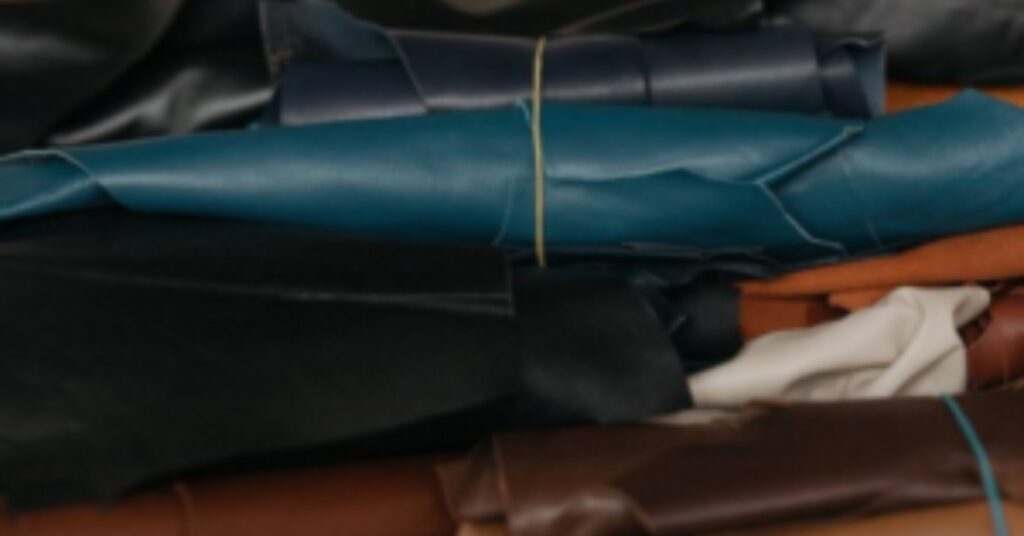
Here’s a quick comparison of how various leather types respond to water exposure:
Suede: Very sensitive to water. It soaks easily and can get ruined if not dried properly. Blot the water immediately, then use a hairdryer and a brush to revive the nap before it hardens.
Grained Leather: More resistant to water, especially if chrome-tanned or finished with a protective layer. However, it can still stain if not dried quickly.
Smooth Leather: Less water-resistant than grained leather. Can absorb water and stain easily, so it’s essential to blot and dry it fast to avoid damage.
Vegetable-Tanned Leather: More absorbent and can soak water. Blot it right away, then use a protective coating to prevent stains.
Saffiano Leather: Water-resistant due to its unique texture and finish. It can handle some moisture, but should still be dried properly to maintain its appearance.
What Happens When Leather Gets Wet
Does Water Ruin Leather?
Leather doesn’t instantly get ruined when it’s wet, but there’s an increased chance of long-term damage if one doesn’t act fast.
Once wet, the material dries, causing natural oils to disappear, which leaves it dry, stiff, and far from its favorite smooth finish.
Visible water stains may appear, and while it’s possible to remove or minimize their appearance, the darkening often leaves a lasting impact on the overall look.
If the wet item fails to dry quickly, it could even rot—the absolute worst case scenario, which is why it’s crucial to keep leather dry. For those wondering, “Can Leather Get Wet?”—yes, but it comes with stains, dullness, and the risk of irreversible change if not treated properly.
Signs of Water Damage on Leather
Water damage on leather often shows as dark spots or water stains that don’t go away after drying. The leather may feel stiff, dry, or not as smooth as before.
In some cases, the surface fades, cracks, or starts to smell bad if it didn’t dry quickly. These are clear signs the leather needs care before it gets worse.
How Do You Get the Moisture Out of Leather?
First, blot the surface gently with a dry cloth or paper towel—don’t rub or press too hard. This helps soak up the extra moisture without spreading it deeper.
Then let the leather air dry at room temperature, away from direct heat. Use a soft-bristle brush after drying to help revive the texture.
If the Leather’s still wet:
When leather gets wet, it’s crucial to act quickly. Blot the surface with a dry cloth or colorfast sponge—avoid rubbing or wiping, as this can damage the material. Allow the leather to air dry and become damp, not completely dry, which will help prevent it from harden or becoming stiff.
For items like wallets, always leave them in the closed position during the drying process. This prevents the leather from losing its shape, which could result in it no longer being able to close properly.
Stuff the inside of a leather bag or briefcase with newspaper to help retain its original shape. This also helps absorb moisture from the interior and allows the leather to dry more effectively. Lay flat to ensure even drying.
Never use artificial heat such as a hairdryer, as it can cause the leather to shrink and become stiff. Drying leather too quickly this way can have long-term damaging effects on the material.
Once the leather is damp, apply a good quality conditioner to restore lost oils. Massage the conditioner into the surface and let it dry overnight to help maintain its softness and flexibility.
After the leather is fully dried, give it a gentle buff with a soft cloth. Finish with a spray protector that repels liquids and protects the surface from future staining and damage, especially if your leather has water stains.
How to Rescue and Dry Wet Leather
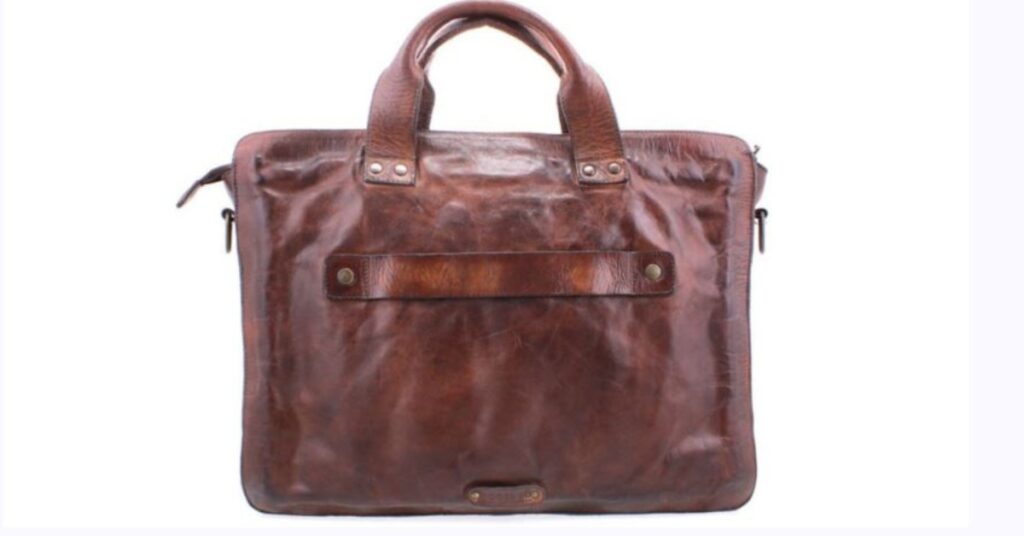
Rescuing Leather – How to Do It
When leather gets wet, act right away to prevent lasting damage. Use an absorbent material like newspaper or a microfiber sponge to gently blot the liquid.
To help restore its shape, stuff the item with newspaper and let it dry in a cool spot. Avoid panic—speed is key to preserving your leather.
Dry Wet Leather Bags and Briefcases
If your leather bag or briefcase gets soaked in a rain shower, don’t panic. Simply stuff the interior with newspaper to help the leather retain its shape and absorb moisture. Lay it flat on a hard surface like a table and let it air dry naturally.
Avoid heat sources such as a hairdryer or radiator, as these can damage the leather and cause it to become wrinkled or crumpled. The drying process should be gradual, allowing the leather to maintain its shape without any harm.
How to Care for Dried Water Stains on Leather
When asking yourself, Can Leather Get Wet?, it’s important to understand that even if leather is water-resistant, it can still get damaged by dried water stains. Start by testing a high-quality leather cleaner on a small section of the leather to check for any possible discoloration. Once safe, gently wipe the stain with a small amount of the cleaner, removing any excess residue to avoid harm to the leather.
After treating the stain, leave the leather to dry in a clean, cool location, away from direct sunlight or heat sources that could damage the material. You might also consider applying a conditioner to the spot and even to the entire item to prevent blotchy drying and keep the leather in good shape.
Once dry, gently buff off any leftover conditioner and let the leather dry again in the same place to ensure it stays intact and looks fresh for a long time.
How to Treat Dried Water Stains in Your Suede
To get rid of dried water stains on leather, gently dampening a lint-free cloth and barely dampening the surface can help. Dab from the seam to the edge of the stain, making it come out more evenly with the rest of the leather. Waiting too long to treat it will make it harder to remove.
Leather Protection & Long-Term Care
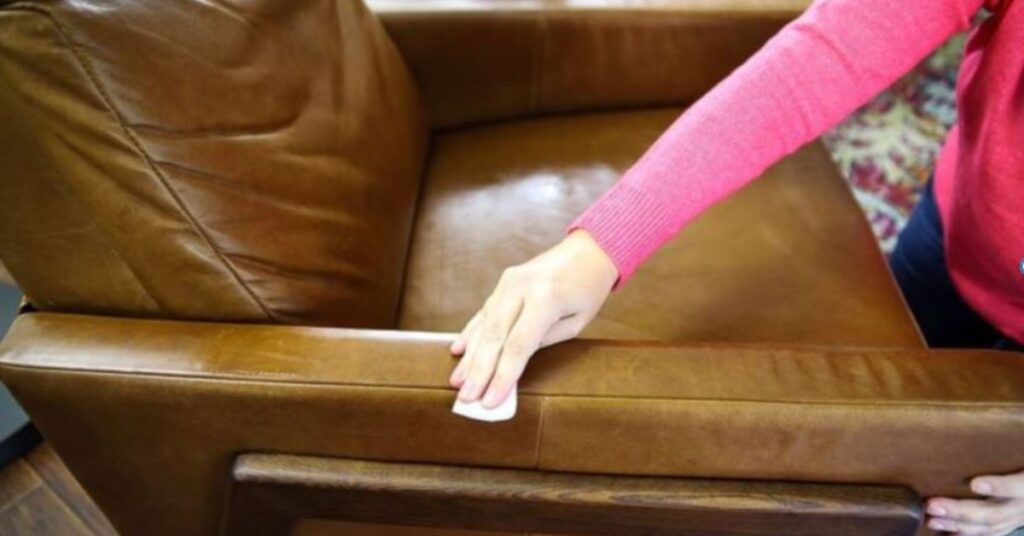
Best Leather Care Kits for Wet Weather
If you live in a wet climate, having the right leather care kit can make all the difference. Look for products that include a high-quality leather cleaner, conditioner, and waterproofing spray to protect your leather footwear, bags, and other items. These kits help prevent water stains, discoloration, and other damage caused by moisture.
A leather care kit designed for wet weather will keep your leather supple, breathable, and looking great. Make sure to test any new product on a small section first to avoid blotchy drying and ensure it works well for your specific leather. Proper care will ensure your leather lasts for many years, even in challenging weather conditions.
DIY vs Professional Leather Care – What’s Safer
DIY leather care can be a good option for routine maintenance, but it requires precision. If you don’t use the right cleaners, conditioners, or waterproofing agents, you risk damage or uneven results that could shorten the lifespan of your leather.
However, opting for professional leather care ensures that your items are treated with the expertise and specialized products they need. Professionals are equipped to handle all types of leather, protecting them from stains, cracks, and other damage, making it a safer bet for valuable or intricate pieces.
How to Clean a Leather Jacket and Make It Last
A genuine leather jacket is an investment designed to last for years and even become hand-me-downs. To keep it in top condition, clean it regularly and let it dry naturally if it gets wet. With proper care, your jacket will remain stylish and ready for the long haul, looking as good as the day you bought it. Manufacturers craft these jackets to endure, but it’s up to you to maintain them.
Prevention Tips
Preventing Leather from Getting Wet
To maintain your leather items like bags, wallets, gloves, and shoes, pre-treating them is essential. Using treatments and sprays designed for water resistance can help protect your leather from water damage. Keep in mind, leather is permeable, meaning it will never be fully waterproof, but water resistance is the best you can aim for.
For added protection, consider applying beeswax cream, which serves as a natural water resisting solution. Always test on a small patch first to ensure it doesn’t cause any darkening effect. Natural oils can also be applied to replace lost oil, helping to seal in moisture and keep your leather in top condition.
Regular maintenance is key. Use a leather conditioner at least twice a year, applying it in a circular motion and wiping off any excess with a damp cloth. This will prevent dirt from entering the pores and maintain the leather’s durability. If your leather is exposed to water, make sure to clean it and apply treatments to preserve its longevity.
For non-suede and non-nubuck leather, a synthetic spray can form a waterproof barrier. For suede or nubuck, use a waterproofing spray specifically made for these materials to avoid cracking and preserve the leather’s texture. Never use artificial heat to dry wet leather, as this can cause irreversible damage.
Bonus Knowledge
Myths About Leather and Water – Busted!
A common myth is that leather is waterproof. While leather can handle some moisture, it’s never fully waterproof. Over time, water can cause deterioration if the leather is repeatedly exposed to it.
Another myth is that leather can’t be treated for water resistance. With the right treatments and sprays, like those containing natural oils, you can seal your leather and improve its water resistance, keeping it in great condition for years.
Final Thoughts: Can Leather Survive Water Exposure?
When asking, “Can leather get wet?” it’s important to understand that while leather is durable, it’s not completely waterproof. Exposure to water can cause deterioration over time, especially if it happens repeatedly.
To keep leather in top condition, using water-resistant treatments can help protect it. So, if you care for your leather properly, it can survive water exposure, but the key is prevention and regular maintenance.

